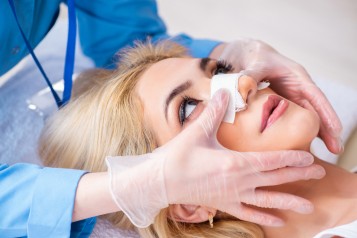Pearly white and aligned teeth is something everyone strives for. Thankfully, there are alternate fixes to achieving the perfect smile outside of traditional braces. Like traditional braces, clear aligners are designed to move teeth a little at a time. Over time, teeth reach their ideal places. Sounds super technical, right? We caught up with Dr. Rhonda Kalasho, a board-certified dentist highly regarded for her aesthetic workmanship, who breaks down exactly what clear aligners are, its functionality and benefits, and more.
 Photo Credit: Shutterstock
Photo Credit: Shutterstock
Haute Beauty: What are clear aligners?
Dr. Rhonda Kalasho: Clear aligners are transparent plastic resins that are used to move teeth instead of traditional metal braces.
HB: Which patients qualify for this treatment?
RK: With the advancement in the techniques and durability of clear aligners, many cases could be treated with clear aligner technology. Advanced cases like overbites, underbites and even crossbites have all been successfully treated with clear aligners. However, there are many cases, for instance, ones that require palatal advancements or expanders, that still require traditional braces. Even in these cases, however, your dentist may use traditional braces then switch to clear aligners in the middle of your treatment so you are not in traditional metal braces for too long.
HB: How does this treatment compare to traditional braces?
RK: Generally, treatment with clear aligners is a lot less maintenance and moves quicker. It is less of an inhabitance on your life to have clear aligners as opposed to braces. With clear aligners you can remove them, brush and floss your teeth, eat comfortably, all the while still move your teeth effectively and efficiently.
HB: What are the benefits of braces?
RK: Braces give more control to the dentist in that it is easier to tweak individual tooth movement in the middle of treatment. Braces also incorporate palatal expanders or functional properties that can change the skeletal aspects of persons orthodontic treatment that clear aligners cannot do. This includes expanding a very narrow arch or narrowing a very wide jaw.
HB: Which patients would you recommend braces to?
RK: Because clear aligners only work when someone is wearing them, I recommend clear aligners for patients who will be diligent and good about wearing them for at least 20-22 hours of the day. Braces are great for those who know that maybe they will lose them, or forget to wear them, like my busy patients or my very young patients.
HB: Which treatment is easier to maintain?
RK: Clear aligners are a lot easier to maintain from an oral hygiene standpoint. You can remove them and brush and floss your teeth, and just pop them back in when done. It is a lot more freeing. Every week to two weeks you change your clear aligner tray to the next, and with every tray, you get closer and closer to the final result, which is incredibly exciting!
HB: Which treatment provides quicker results?
RK: Clear aligners incrementally move the teeth and every time you change your tray your teeth and moving closer and closer to the final result. It certainly feels a lot quicker when in clear aligners, and studies show that indeed, produce faster results.

























